The Kwomtari Phylum
(This Site is still under Construction)
Wietze Baron
Started:
October 2007
December 1st 2023 note: For more specific information on the Fas (Momu)
language see:
Language classifications
As in biology with its classification of species, linguists also have a need for classification. They used to use terms like Phylum, Stock, Family and Dialects to classify the languages of the world. The phyla were the broadest groups. These were in turn subdivided in terms of stocks, stocks in terms of families etc. But as the relationships turned out to be too complex for such a simple taxonomy, the tendency is now to respresent them in terms of tree structures. A broad, largely geographically determined, division is made in terms of PHYLA, and from there on all we find is Language Trees.
Cf. Global Mapping International and The Ethnologue, languages of the world
We lived as a family in the Fas (Momu)-speaking village of Kilifas, Sandaun Province, Papua New Guinea. Papuan languages have traditionally been considered impossible to place within external phyla. Even within Papua New Guinea itself, languages were so diverse that a number of special phyla were laid out. The Fas-language had been placed in the Kwomtari Phylum by Loving and Bass.
They suggested the following language tree:
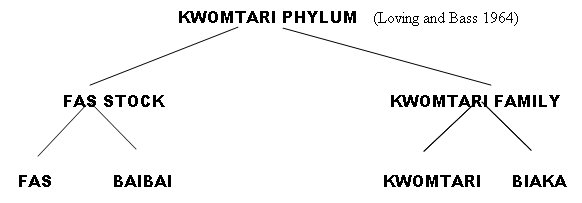
Kwomtari and Biaka are clearly fairly closely related languages, but Fas and Baibai are even closer. It therefore made no sense that they were grouped at a Stock level. I was able to consult their survey data and it turned out that in their typed data sheets, a large part of the corpus had been skewed, probably by a typing error where the glosses appeared a line lower than the items they belonged to. This may also have put Don Laycock off the track, when in 1975 he suggested the following classification

Laycock added PYU on the border with Irian Jaya.
My family lived in the Fas speaking village of Kilifas, intermittently from 1977 - 1988. In 1983 I was able to carry out a helicopter supported survey of key locations within this phylum. A short wordlist of 100 items was used, but I also looked at aspects of syntax and morphology. As a result I suggested the following language tree:
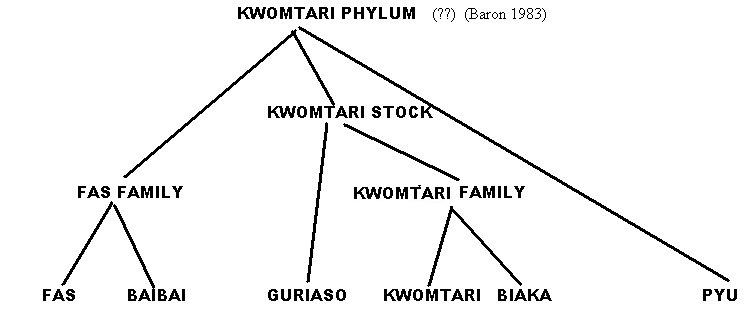
The survey revealed the existence of a hitherto unkown language which I have called GURIASO, following the name of a central village. I frankly have no idea of what the phylum and stock characteristics would be in this representation. In that respect I am simply following the Loving and Bass and Laycock precedent. A copy of the report was sent to the Linguistics Department of SIL Ukarumpa, the Linguistics Department of the University of Papua New Guinea and to the Australian National University (care of Stephen Wurm and Don Laycock). Don Laycock responded a year or so later expressing strong feelings that PYU was part of this taxonomy. The rough draft is now available: Kwomtari Survey A summary is contained in my paper called Malay Influence on West Sepik Kinship Terminology., read at a meeting of the Linguistic Society of Papua New Guinea.
A Geographic Outline of the Kwomtari Phylum Territory
(to be
replaced)
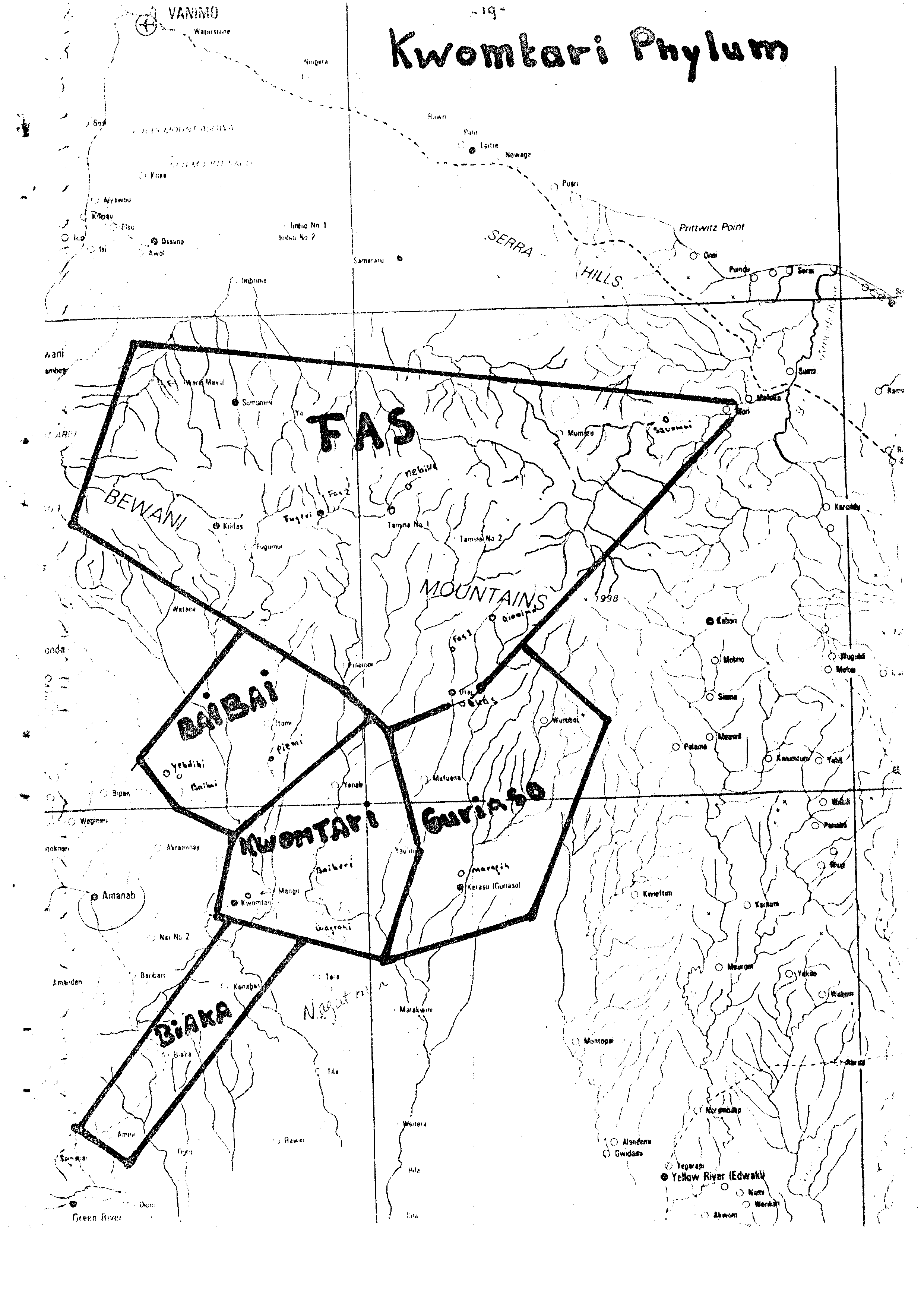
Village index
This index lists the villages belonging to each language and the population
figures from the 1979 census. As you can tell from names like Tamina 1, Tamina
2 etc., the names were often thought up by patrol officers. People
traditionally live in small clan hamlets. Government authorities put pressure
on them to go and live in larger villages.
|
FAS |
Resident |
Absent |
Total |
|
Yo |
82 |
13 |
95 |
|
Sumumini |
119 |
4 |
123 |
|
Wara Mayu |
57 |
20 |
77 |
|
Kilifas |
120 |
17 |
137 |
|
Fugumui |
114 |
10 |
124 |
|
Fas 2 |
117 |
17 |
134 |
|
Fas 3 |
77 |
13 |
90 |
|
Finamui |
30 |
8 |
38 |
|
Fugeri |
128 |
8 |
136 |
|
Aiamina |
68 |
5 |
73 |
|
Tamina 1 |
73 |
9 |
82 |
|
Nebike |
132 |
4 |
136 |
|
Tamina 2 |
40 |
17 |
57 |
|
Utai |
81 |
3 |
84 |
|
Mumuru |
99 |
7 |
106 |
|
Savamui |
32 |
18 |
50 |
|
Mori |
78 |
9 |
87 |
|
Total |
1447 |
182 |
1629 |
|
|
|
|
|
|
BAIBAI |
Resident |
Absent |
Total |
|
Itomi |
65 |
15 |
80 |
|
Piemi |
47 |
10 |
57 |
|
Baibai |
60 |
16 |
76 |
|
Yebdibi |
70 |
1 |
71 |
|
Total |
242 |
42 |
284 |
|
|
|
|
|
|
KWOMTARI |
Resident |
Absent |
Total |
|
Mango |
64 |
1 |
65 |
|
Kwomtari |
86 |
12 |
98 |
|
Baiberi |
79 |
23 |
102 |
|
Yenabi |
109 |
41 |
150 |
|
Yau'uri |
84 |
20 |
415 |
|
Wagroni |
39 |
? |
>39 |
|
Total |
461 |
>97 |
>558 |
|
|
|
|
|
|
BIAKA |
Resident |
Absent |
Total |
|
Konabasi |
146 |
6 |
152 |
|
Biaka |
200 |
9 |
209 |
|
Amini |
100 |
? |
>100 |
|
Total |
446 |
>15 |
>461 |
|
|
|
|
|
|
Grand total |
2596 |
>336 |
>2932 |
Fas
Kwomtari
Fas (Momu)
FAS was the name given to people and the language in the Northern section of the phylum. There is nowhere a village to be found that is itself called FAS. Two villages are called Fas followed by a number: Fas 2 and Fas 3. A third village is called Kilifas. This may well have been considered to be Fas 1 by name giving patrol officers. The people themselves now refer to these villages as Tufas ("Two Fas") and Trifas ("Three Fas"). Kilifas they pronounce as Krifas. As I'll explain in the section on Kilifas, I believe the original patrol officer given name was also 'TriFas' (Fas number 3). "Fas" itself is used for an area within the region. (A 12/2012 note: Fiona Blake (2007) reported on the desire of people in the Northern villages, to call their language by their word for "no", that is Momu. During my recent trip to Kilifas it became clear that here to "Momu" would be the word of choice for their language. This may heve to be taken seriously. See my earlier note further down this paper.)
The Territory of the Fas (Momu) people (exact borders unknown)
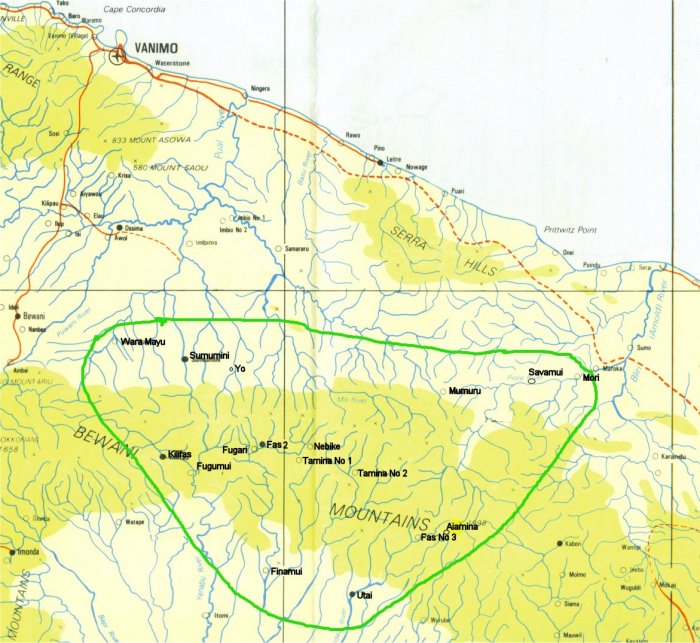
Articles on Fas
Overview of Fas Phonology (Wietze Baron)
Light from the Dark Ages of Chomsky and Halle's "Abstrct Phonology"
Cases of Counter-Feeding in Fas (Wietze Baron)
Kwomtari Survey (Wietze Baron)
New: Orthographic Mismatches: Fas vs Melanesian Pidgin (revised) (Wietze Baron)
Malay Influence on West Sepik Kinship Terminology (Wietze Baron)
(Notes on) Aspects of Tense and Aspect in Fas (Wietze Baron)
Spatial Reference in Momu (Fiona Blake)
Tom Honeyman's personal page (working on a PHD in Fas/Momu)
Wikipedia Article on the Kwomtari-Fas Phylum
Report on a recent trip to Kilifas
To appear:
Towards a Phonology of Fas
Towards a Fas Grammar
New: Fas (TokPisin – English Lexicon)
Kilifas
Kilifas is the name of the Fas speaking village on the Yenebu river. When I left in 1989 the houses were situated on the northern bank of the river. Due to a severe flood, the river changed its course and the village has now moved to the other side. The name "Kilifas" has an interesting history. The Fas language does not have and 'l' and Fas speakers do not try and twist their tongues to pronounce it. They call the village "KRIFAS". Villages in this area are government induced. Patrol officers (called "KIAPs") requested (if not required) the people who traditionally live in small clan size hamlets to have communual villages. These villages where then given names. Names were often based on the name of the rivers they were located on. Fas speakers added their own suffix -muy, which meant "people (of)". So we get Finamoi (should have been Fine-muy), meaning "people of the river Fine", also Fugumoi (really Fuky-muy ) and Savamui (possibly Saf-muy).
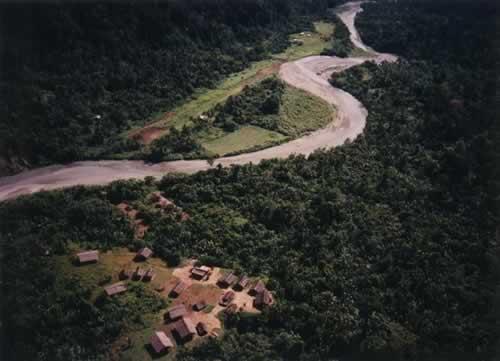
Aerial picture of Kilifas after it had been washed away by theYenebu river and was rebuilt on the other side. (90's)
So, back to the Kilifas mystery. There are two more villages officially called Fas, i.e. Fas 2 and Fas 3. These are locally called Tufas and Trifas ("Two Fas" and "Three Fas"). So where is "One Fas" ? Or just "Fas"? I have not been able to find an origin for the word "kili" or "kri", not in Fas itself, neither in any neigbouring language nor in Malay which had its influence in the area. It is my belief that Kilifas was originally called / Trifas/, i.e "Three Fas". An 'l' does seem to exist in Baibai, the closely related neigbouring language and there is very regular interchange of r and k in Baibai and Fas, where Fas has [k] and Baibai [r],
e.g. Fas Baibai O = open rounded back vowel E = open front vowel e =shwa
hakO harO "egg"
kemas remas 'bow'
fek fere 'house"
kakefi rarefi "tabacco" also kafeki via kf-metathesis
kamesO rasmO "smoke" sm-metathesis involved
I could imagine that Baibai speakers reinterpreted [trifas] as [k(i)lifas] hearing a [k] and an [l] in [tr]. Subsequent patrol officers hearing it pronounced this way, then officially recorded it as KILIFAS. With this "Trifas" out of the way there was room for a new "Trifas" ("Fas 3") when it was discovered.
THE FAS LANGUAGE
The Fas language is spoken by less than 2000 speakers in 17 main villages. The villagers tend to spend long periods in their clan hamlets. The name Fas was given to the language by linguists, possibly Loving and Bas in 1964. Before that Capell (1962) had surveyed the area and calls the "dialects"spoken in the Bewani mountains "Bembi". He claims that a dialect of the language is also spoken near Abau, which is way South near what is now Green River. As Fas has no prenasalised stops, it is likely that his name source was "Baibai", a closely related language which has voiced and prenasalised stops. The sample data he presents is very likely Fas (unless Baibai close resembles these forms). From these data he concludes that Fas incorporates pronoun objects in the verb. He is right but the data don't show it.
Symbols used for the "Actual" rendering: O = open rounded back vowel E = open front vowel e =shwa yi = high front vowel
Capell: Fi nabuana 'Give me water'
Actual: fyi nE- puen - E fi nEpuenE !
Gloss water with - come - imperative "Come and bring water!"
Capell: fi nawo 'Give him water'
Actual fyi nOw -O
Gloss water give - imperative "Give (him/her) water !"
For more on Fas grammar see the references earlier on.
Fiona Blake (2007) carried out a research programme for her BA thesis in the Fas speaking village of Mori, in the North. She met with reluctance amongst the villagers to use the name of another village, i.e Fas, for their language. Upon which she decided to christen the language "Momu", the Fas word for "NO". There is a tradition in the Sepik region to do so, and I am sympathetic to the idea of another name, but we may wel have to wait till the various villages can come together and decide on their own name. A change of names has the problem of breaking a linguistic classificatory tradition, as the language has been called Fas in all of the preceding literature. Also using the word for "NO" is potentially problematic in that related languages may employ the very same term. This is actually the case for Fas, where the closely related language Baibai also uses the negation "Momu".
To be continued!
Kwomtari
References:
Introduction to the Kwomtari People and Language (Honsberger, Murray, Carol Honsberger and Ian Tupper) Introduction to Kwomtari Phonology (Julia Drew) and Kwomtari Grammar Essentials (Katharine Spencer) all of them in http://www.sil.org/pacific/png/pubs/50948/Kwomtari_Grammar_Phonology.pdf
Wikipedia: http://en.wikipedia.org/wiki/Kwomtari-Baibai_languages